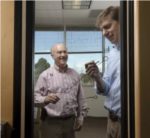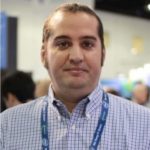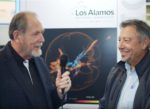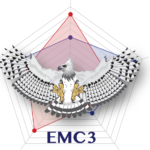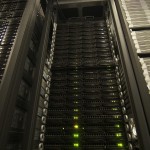Researchers at Los Alamos National Laboratory have created the largest simulation to date of an entire gene of DNA, a feat that required one billion atoms to model and will help researchers to better understand and develop cures for diseases like cancer. “It is important to understand DNA at this level of detail because we want to understand precisely how genes turn on and off,” said Karissa Sanbonmatsu, a structural biologist at Los Alamos. “Knowing how this happens could unlock the secrets to how many diseases occur.”
Video: A History of Los Alamos National Lab
Terry Wallace from Los Alamos National Lab gave this talk at the HPC User Forum. “The Laboratory was established in 1943 as site Y of the Manhattan Project for a single purpose: to design and build an atomic bomb. It took just 27 months. The Los Alamos of today has a heightened focus on worker safety and security awareness, with the ever-present core values of intellectual freedom, scientific excellence, and national service. Outstanding science underpins the Laboratory’s past and its future.”
Video: LANL Open Sources DeltaFS software for Wrangling Trillions of Files
A new distributed file system for HPC being distributed today via GitHub provides unprecedented performance for creating, updating and managing extreme numbers of files. “We designed DeltaFS to enable the creation of trillions of files,” said Brad Settlemyer, a Los Alamos computer scientist and project leader. “Such a tool aids researchers in solving classical problems in high-performance computing, such as particle trajectory tracking or vortex detection.”
Podcast: ECP EXAALT Program Extends the Reach of Molecular Dynamics
Computationally, EXAALT’s goal is to develop a comprehensive molecular dynamics capability for exascale. “The user should be able to say, ‘I’m interested in this kind of system size, timescale, and accuracy,’ and directly access the regime without being constrained by the usual scaling paths of current codes,” said Danny Perez of Los Alamos National Laboratory (LANL) and the EXAALT team.
LANL Upgrades to D-Wave 2000Q Quantum Computer
Today D-Wave Systems announced that Los Alamos National Laboratory has upgraded their D-Wave quantum computer to the D-Wave 2000Q system. Los Alamos is investing in D-Wave quantum technology to expand its foundational quantum computing research, enabling exploration of new and diverse quantum computing applications. “We are pleased that the Department of Energy’s National Nuclear Security Administration Advanced Simulation and Computing program funded the upgrade of the D-Wave system, allowing us to continue to explore quantum simulation and algorithms at larger scales,” said Irene Qualters, associate laboratory director for Simulation and Computation at Los Alamos National Laboratory. “D-Wave has been a valued strategic partner in Los Alamos’ pursuit of a new technology that is part of the expanding heterogeneous landscape of computing. Such strong partnerships aid the Laboratory and DOE in the development of the nation’s workforce for the future.”
LANL Solicits Bids for 18 MW Crossroads Supercomputer for Delivery in 2021
The next big supercomputer is out for bid. An RFP was released today for Crossroads, an 18 Megawatt system that will support the nation’s Stockpile Stewardship Program. “Los Alamos National Laboratory is proud to serve as the home of Crossroads. This high-performance computer will continue the Laboratory’s tradition of deploying unique capabilities to achieve our mission of national security science,” said Thom Mason from LANL.”
Video: Ramping up for Exascale at the National Labs
In this video from the Exascale Computing Project, Dave Montoya from LANL describes the continuous software integration effort at DOE facilities where exascale computers will be located sometime in the next 3-4 years. “A key aspect of the Exascale Computing Project’s continuous integration activities is ensuring that the software in development for exascale can efficiently be deployed at the facilities and that it properly blends with the facilities’ many software components. As is commonly understood in the realm of high-performance computing, integration is very challenging: both the hardware and software are complex, with a huge amount of dependencies, and creating the associated essential healthy software ecosystem requires abundant testing.”
nCorium Startup joins LANL’s Efficient Mission Centric Computing Consortium for Ultra-scale Efficiency
The San Jose-based startup company nCorium has joined Los Alamos National Laboratory’s Efficient Mission Centric Computing Consortium (EMC3) in the quest for efficient, ultra-scale computing. “We are excited to be working with nCorium to explore moving data multiple times faster than current approaches while adding value to the data as it moves,” said Gary Grider, HPC Division Leader at Los Alamos. “The prospect of using far less data movement/storage nodes in our environment while providing more in-flight data manipulation is an important step towards the higher efficiencies that the EMC3 seeks.”
Balancing the Load – A Million Cores in Concert
“If you’re doing any kind of parallel simulation, and you have a bit of imbalance, all the other cores have to wait for the slowest one,” Junghans says, a problem that compounds as the computing system’s size grows. “The bigger you go on scale, the more these tiny imbalances matter.” On a system like LANL’s Trinity supercomputer up to 999,999 cores could idle, waiting on a single one to complete a task.
Earth-modeling System steps up to Exascale
“Unveiled today by the DOE, E3SM is a state-of-the-science modeling project that uses the world’s fastest computers to more accurately understand how Earth’s climate work and can evolve into the future. The goal: to support DOE’s mission to plan for robust, efficient, and cost-effective energy infrastructures now, and into the distant future.”



